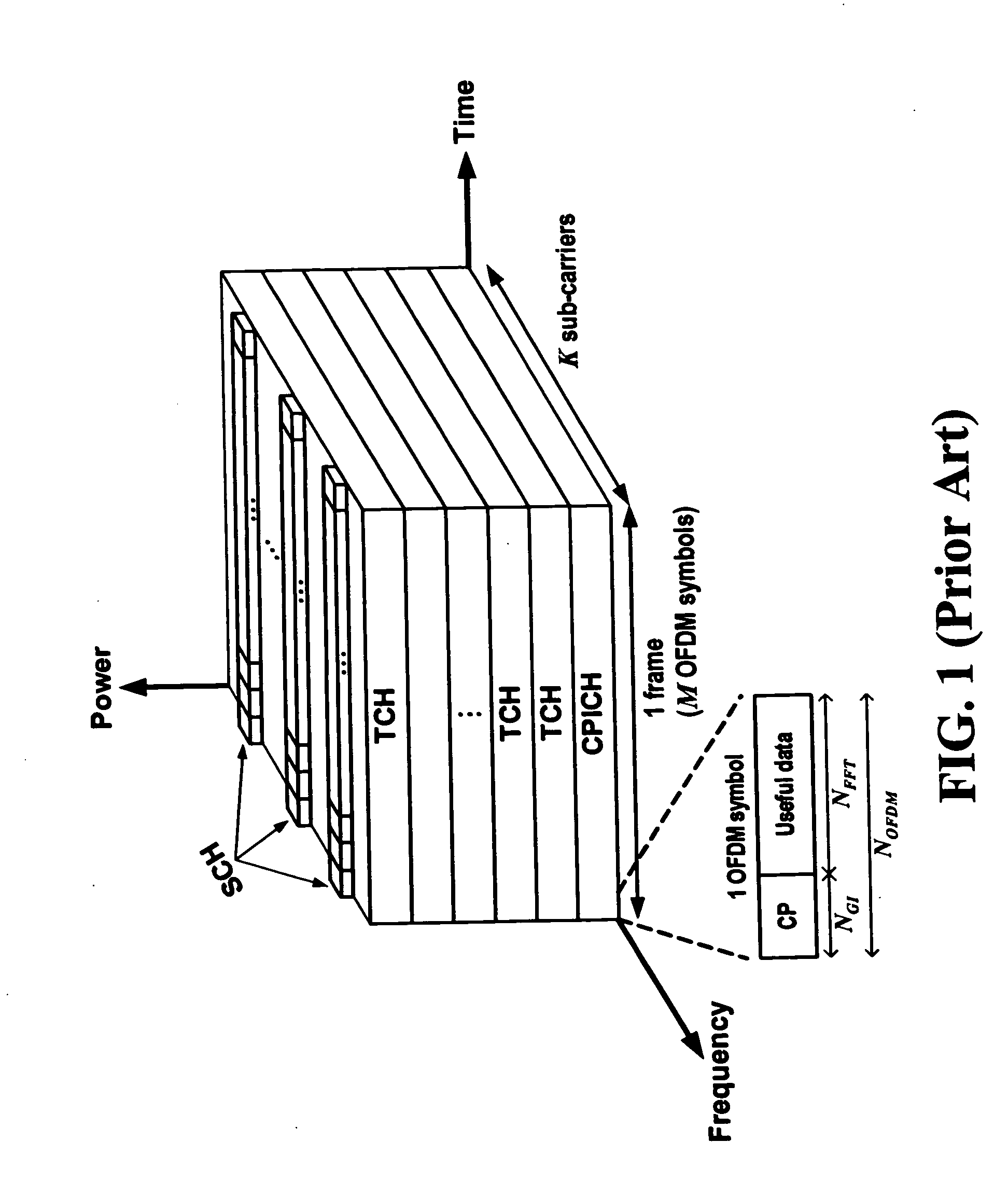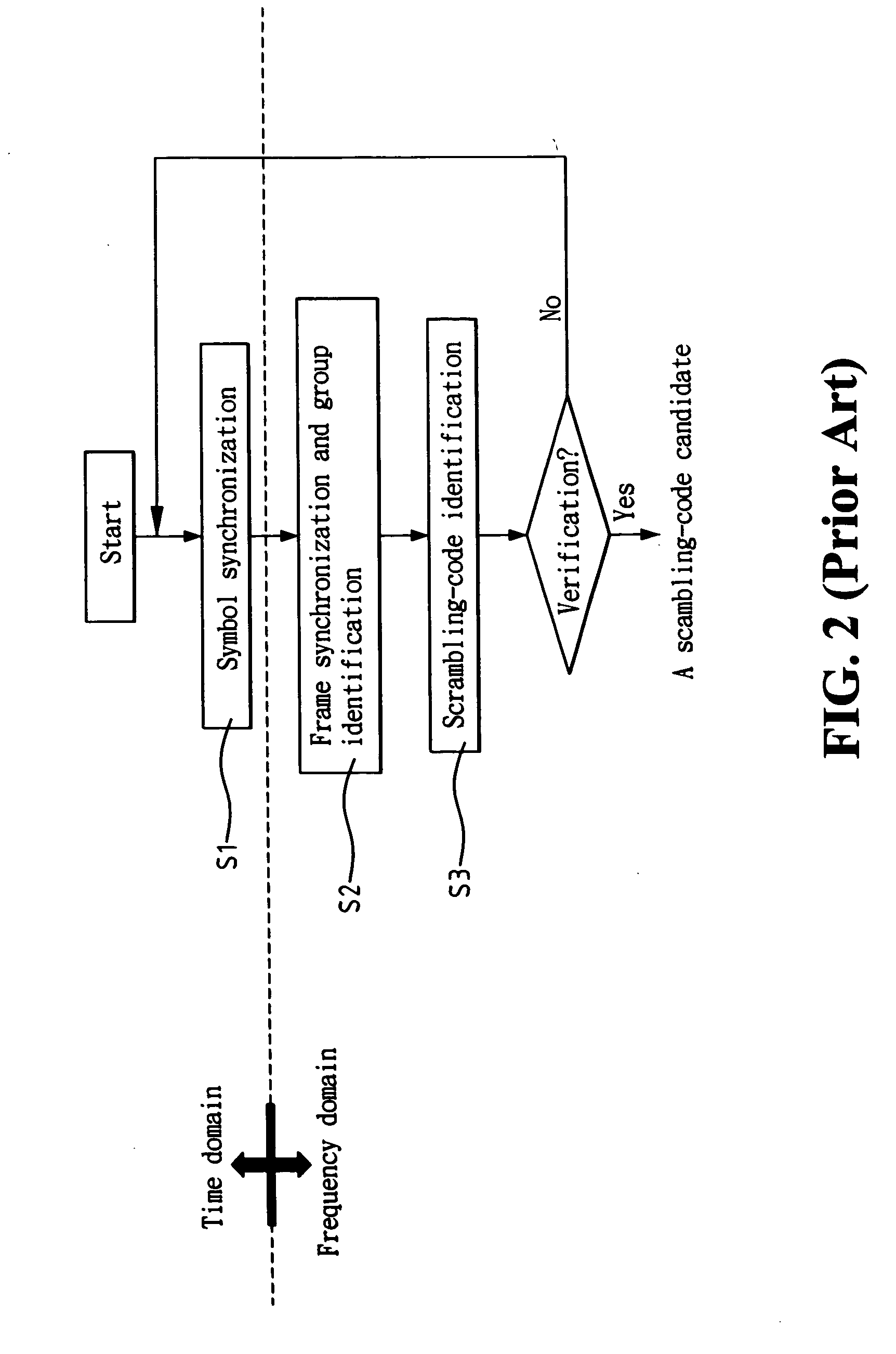Cell search method for orthogonal frequency division multiplexing based cellular communication system
a cell search and orthogonal frequency division technology, applied in orthogonal multiplex, synchronisation signal speed/phase control, synchronisation arrangement, etc., can solve the problem of degraded cell detection performance of sch-based method, direct influence of search method on perceived switch-on delay, link quality and power consumption of an ms,
- Summary
- Abstract
- Description
- Claims
- Application Information
AI Technical Summary
Benefits of technology
Problems solved by technology
Method used
Image
Examples
first embodiment
[0035]FIG. 8a shows the time-domain flame structure according to the invention. Referring to FIG. 8a, the first and second OFDM symbols in a frame are CPICH1 and CPICH2, respectively. The remaining (M−2) OFDM symbols in a flame, indicated by TCHs, are used for transmitting TCH data. Clearly, CPICH signal is orthogonal to TCH signal. Let s(j)[n] denote the downlink-transmitted signal associated with cell j. In a flame as shown in FIG. 8a, the transmitted signal of mth OFDM symbol is represented as sm(j)[n], n=0˜NFFT-1, without taking GI into account. FIG. 8b shows another view of the flame structure in FIG. 8a, where RCPICH is the power ratio of CPICH signal to the signal of one TCH and K is the number of sub-carriers used in an OFDM symbol.
[0036]FIG. 9a shows the detailed structure of CPICH1 in FIG. 8a The time-domain CPICH1 signal, s0(j)[n], n=0˜NFFT-1, is comprised of NR replica of the time-domain short sequence, x1(j)[n], n=0˜v-1, as follows:
s0(j)[n]=x1(j)[((n))v], n=0˜NFFT-1 ...
second embodiment
[0049] Subsequently, the present invention with relatively low complexity is provided.
[0050]FIG. 12a shows the time-domain frame structure according to the second embodiment of the present invention. Referring to FIG. 12a, the first OFDM symbol in a frame is CPICH. The remaining (M−1) OFDM symbols in a frame are used for transmitting TCH data FIG. 12b shows the detailed structure of CPICH in FIG. 12a. The time-domain CPICH signal, s0(j)[n], n=0˜NFFT-1, is comprised of NR replica of the time-domain short sequence, x(j)[n], n=0˜v-1, as follows:
s0(j)[n]=x(j)[((n))v], n=0˜NFFT-1 (16)
In other words, the time-domain CPICH signal s0(j)[n] is periodic with period v. The time-domain short sequence x(j)[n] can be obtained by taking v-point IDFT (IFFT) of of the following frequency-domain short sequence: X(j)[2k]=B(j)[k],k=0~u2-1 and(17a)X(j)[2k+1]=B(j)[k]·A(j)[k],k=0~u2-1(17b)
[0051] The frequency-domain short sequence X(j)[k] (or, equivalently, B(j)[k] and A(j)[k]) can be des...
PUM
 Login to View More
Login to View More Abstract
Description
Claims
Application Information
 Login to View More
Login to View More - R&D
- Intellectual Property
- Life Sciences
- Materials
- Tech Scout
- Unparalleled Data Quality
- Higher Quality Content
- 60% Fewer Hallucinations
Browse by: Latest US Patents, China's latest patents, Technical Efficacy Thesaurus, Application Domain, Technology Topic, Popular Technical Reports.
© 2025 PatSnap. All rights reserved.Legal|Privacy policy|Modern Slavery Act Transparency Statement|Sitemap|About US| Contact US: help@patsnap.com



